Craftsman’s tour de force
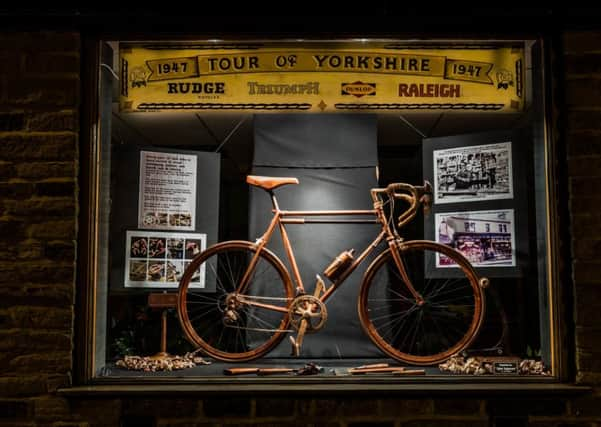

Richard Uttley’s wife is very understanding about his obsession with wood. He spends hours in his shed designing and hand-carving works of art purely for his own pleasure and their house is full to bursting with his incredible carpentry creations.
But even she reached exasperation point with his latest project – a remarkable life-size replica of a road bike carved by hand entirely from wood.
Advertisement
Hide AdAdvertisement
Hide AdIt took a year to complete and presented numerous technical problems that tested his woodworking wizardry.
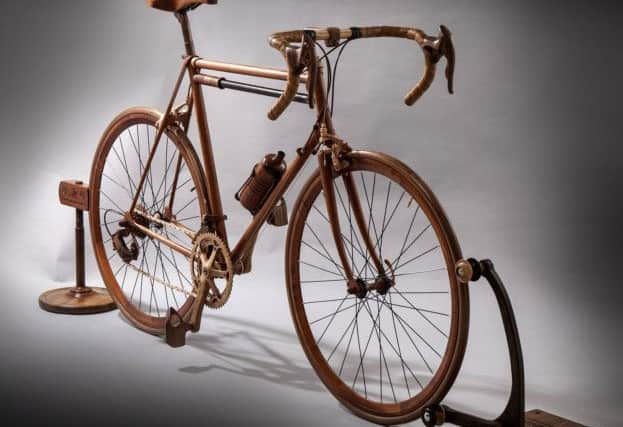

“I started with the rims and they took 100 hours so I stopped counting after that. My wife is very patient and supportive but she did accuse me of thinking more about the bike than I did of her at one point,” says Richard, who took on the cycling challenge after seeing Calderdale “trimmed up” for last year’s Tour de Yorkshire.
The rusty old bikes painted yellow were all very well, he says: “But I thought, ‘I can do better than that.’”
The result is a trompe l’oeil masterpiece now on display in the window of A Little Bit of Eden, a florists shop on Wharf Street, Sowerby Bridge, run by Bev Darwin.
Advertisement
Hide AdAdvertisement
Hide Ad“Someone thought it was a real bike painted brown, it’s so good,” says Bev, who had previously given over her window to Richard’s timber rendition of “The Glorious Twelfth” complete with a wooden waxed jacket, rifle, cartridge bag and gun belt.
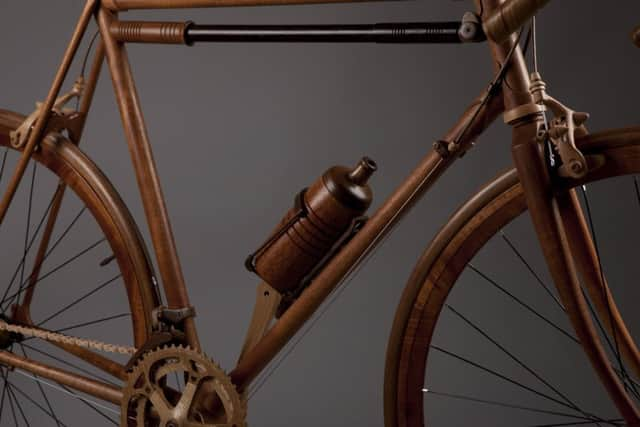

He was keen for his bike to be displayed in the shop as it holds many memories for him and legions of others who grew up in and around the town.
Between 1938 and the early 1970s, the building and what is now a deli next door, was Cyril Sands cycle shop.
It was a mecca for everyone from children who needed help with a puncture or a mangled wheel to those who wanted to buy a decent bike to get to and from work.
Advertisement
Hide AdAdvertisement
Hide Ad“Everyone remembers Cyril’s shop. I loved it and I always remember the smell of rubber compound from the tyres.
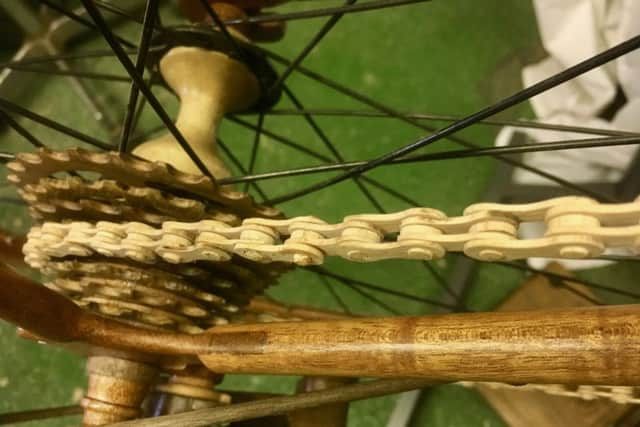

“Cyril was a legend. His shop was jam-packed with bikes, frames and parts and there was nothing he couldn’t fix,” says Richard, 61, who went on to become a time-served joiner and carpenter.
After spending his working life on joinery projects all over the world, he is now free to do his own thing.
“I’ve always loved wood and I can tell what type it is just by the smell of it.
Advertisement
Hide AdAdvertisement
Hide Ad“I make whatever I fancy and I’ve done all sorts from wooden clocks and a pair of 1940s army boots to gun belts but this bike is the hardest thing I’ve ever done.
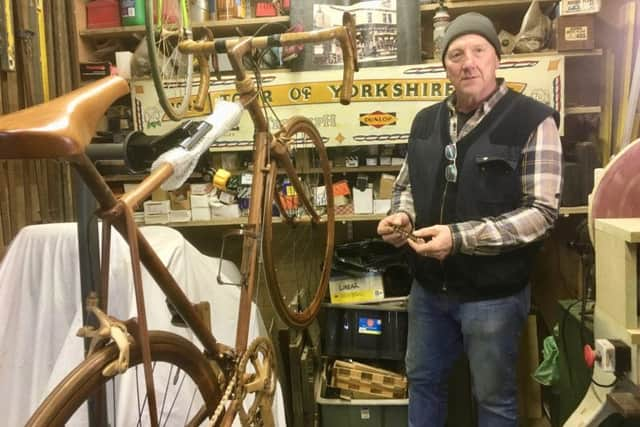

“I thought it would take two years but then I asked Bev if I could display it in the shop for this year’s Tour de Yorkshire, which gave me a tighter deadline.”
It is modelled on the last bike he rode before his knees forced him out of the saddle – a 1992 cycle with a Reynolds 531 frame and Campagnolo Chorus gears.
He used his prized piece of Brazilian mahogany, along with oak, walnut, beech, cherry and ash.
Advertisement
Hide AdAdvertisement
Hide AdThe attention to detail is meticulous. Every link in the chain is hand-carved, as are the saddle, brake cables, handlebar tape and the derailleur gears, which were the hardest bit. The tyres are steam-bent wood and there’s even a wooden water bottle.
The only items that are non-wood are the spokes and the inner of the brake cable.
For his window display, Richard asked a friend at Halifax signs to paint a vintage-style sign featuring a fictional race – the Tour of Yorkshire 1947 – and Cyril Sands’ son provided old photographs of that legendary cycle shop.
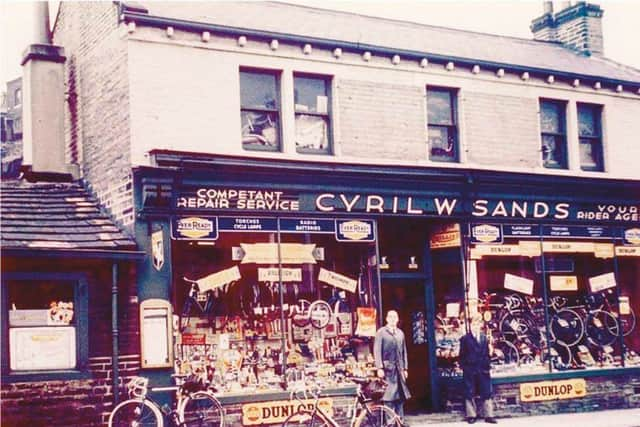

Cyril bought his Sowerby Bridge shop in 1938 just before he was called up to serve in the war.
Advertisement
Hide AdAdvertisement
Hide AdAt that time, there was a big demand for cycles. A bike wasn’t just for fun, it represented freedom and pushed boundaries because working class people did not have cars and mainly relied on Shanks’s Pony. It also helped extend the gene pool and played a part in emancipating women.
When Cyril was called up to serve in the war, his wife, Edith, took over behind the counter.
Their son David, 79, recalls being in a playpen in the shop window and, when he was older, helping out.
“Dad was a workaholic and was rarely home before 9pm. When he married my mum, the wedding service was at 8am so it would be over in time for him to open the shop at 9am. When they took their honeymoon it was on a tandem to Wales.”
Advertisement
Hide AdAdvertisement
Hide AdHe adds: “There were bikes and frames crammed everywhere. Christmas was a particularly busy time and then, everywhere, including my bedroom was full of bikes. We had no vehicle in the 1950s so we had to hand-deliver them on Christmas Eve.
“We’d ride one while pushing another. The last delivery was about 3am, which meant we got shouted at by angry parents.”
Bicycles and the kit surrounding them have changed since the early 1970s when Cyril retired and shut up shop.
Getting up one of Calderdale’s many hills was a tortuous process with Sturmey Archer two-speed fixed gears – though the ever-shrewd Cyril was one of the first to stock a Cyclemaster motorised bike in 1952. Now, the best bikes can cost up to £7,000 each. One of the most expensive cycles in Cyril Sands shop in 1950 was a Raleigh Lenton at £19, 19 shillings and sixpence, which is about £650 in today’s money. “There was no cycling gear like there is now either. When I was younger, I wore thick corduroy shorts and I can remember cycling to work in the rain in plastic leggings, a cape and a souwester. I’d arrive dripping in sweat,” says David Sands, who recalls his father being very generous with his time.
Advertisement
Hide AdAdvertisement
Hide Ad“I remember a man telling me that he became an engineer because of my dad. He showed him how to fix a problem with his bike when he was a young lad. Dad didn’t have the part needed so he showed him how to make one from a metal spring. That was the moment the lad decided to become an engineer.”
Cyril’s grandson Chris Sands, who is renowned for devising the Totally Locally concept to support independent shops, adds: “It just shows that good independent shops like my grandad’s are vital. It changed that boy’s life and you don’t get that kind of service in Halford’s.”
While Cyril was the main man, Edith was his right-hand woman and it was she who created the shop’s eye-catching window displays.
“She would be very impressed by this one,” says David, in awe of Richard Uttley’s bike surrounded by what appear to be real carpentry tools.
Advertisement
Hide AdAdvertisement
Hide Ad“They’re all made of wood, of course,” says Richard, who is half contemplating selling the bike, but only to the right person.
“The person who bought this bike would have to love cycling and really appreciate it. I’d sell for it for less to someone like that rather than to someone with loads of money who just fancies owning something a bit different.”
He takes the “yellow jersey” for his incredible feat of craftsmanship but he’d like to thank his support team. They include A Little Bit of Eden florists, Sowerby Bridge, James Chambers timber merchants, Julien Whelan, of Halifax signs, Chris Paulson Cycles for help with the spokes, Philip Fearnley Photography Studio and photographer Paul Zdan for their pictures, Eglen Engraving for engraving the bike stand, Sim Print who did the picture boards and David and Chris Sands for old pictures of Cyril Sands and his shop.
To see more of Richard Uttley’s work visit www.woodwithatwist.co.uk